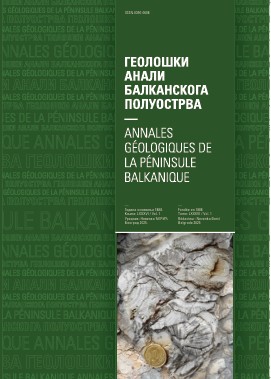Depth geological relations in the Timok Krajina, between Kladovo and Zaječar (eastern Serbia): based on surface, borehole and geophysical data
Abstract
The titled topic refers to the area from the great meander of the Danube River in the north, to Zagrađe, south of Zaječar and, to the west, it main-ly along the length of the mountain edge of the Carpathians, additionally with the intramountain trough of Borska Slatina. To the east of the state border, segments of the transborder area of Romania and Bulgaria are included. The total area of the amoeboid contour is about 2,500 km2, within the orthogonally wider framed map. In geological sense, it includes the westernmost margin of the Dacian Neogene Basin, unconformably formed above the crease belt of the Krajina Pre-Carpathians which was affected by Laramyian-Pyrenean defor-mations; in the trough of Borska Slatina above the Intra-Carpathian mag- matic-volcanic formation, and from the curved route east of the Peri-Carpa-thian contact as the whole cover of consolidated and block-shaped the Moesian Platform. A part of the abundant content of surface, field and cabinet paleontological-stratigraphic, primarily Neogene studies, resulting from the long-term research of recognized authors is displayed in an appropriate manner. Besides, individual representation and intervals from the sites of shallower drilling of different purposes were added. For the first time, the data related to the Neogene and older geological units from the deep boreholes are highlighted, and by well log interpretation and correlation positioned on the attached tables and illustrated with figures. For the first time, the geometry of indented base of the Cenozoic of the entire territory is presented, that is compatible with the geophysical primarily harmonized gravimetric and reflective-seismic indicators. In the Negotin - Zaječar area, we publish the first complex interpretation of the discontinuity of foothills formed as a result of the Alpine orogeny, by depth, above the paleomorphologically formed the Paleozoic Caledonian-Hercynian basement. The greatest thickness of Cenozoic deposits near Velika Vrbica, in the meander of the Danube River, has been interpreted up to 2,300 m, proved near Mala Vrbica (borehole Vb-1, 1,990 m) and, terminates in the Upper Cretaceus of the Carpathian foothills at a depth of 2,497.7 m . The oldest well-defined stratigraphic unit is the Ordovician in the Bukovče-1 borehole near Negotin, with a bottom of 1,982 m on the Krajina part of the Pre-Carboniferous to Sub-Jurassic interval of platform. The deepest borehole in the studied area is 55 Chilia 7, completed in the late Silurian of the Moesian Platform at a depth of 3,203.5 m.
Copyright (c) 2025 Geološki anali Balkanskoga poluostrva

This work is licensed under a Creative Commons Attribution 4.0 International License.










